Prediction Method of Swirling Flame Lean Blowout Based on Flame Image Morphological Features
Abstract
1. Introduction
2. Experimental Setup
3. Prediction Method Based on Flame Image Morphological Features
3.1. Overall Process
3.2. Extraction of Flame Morphological Features
3.3. Multiplying of Flame Morphological Features with Time Series Information
3.4. Blowout State Description Method
3.5. Random Forest Regression Model
4. Results and Discussion
4.1. Prediction Method on LBO
4.2. Discussion about Influence of Time Series Information on Prediction Accuracy
5. Conclusions
Author Contributions
Funding
Institutional Review Board Statement
Informed Consent Statement
Data Availability Statement
Conflicts of Interest
Abbreviations
| LBO | lean blowout |
| RMSE | root mean square error |
| coefficient of determination |
References
- Candel, S.; Durox, D.; Schuller, T.; Palies, P.; Bourgouin, J.F.; Moeck, J.P. Progress and challenges in swirling flame dynamics. Comptes Rendus Mec. 2012, 340, 758–768. [Google Scholar] [CrossRef]
- Broda, J.; Seo, S.; Santoro, R.; Shirhattikar, G.; Yang, V. An experimental study of combustion dynamics of a premixed swirl injector. Symp. (Int.) Combust. 1998, 27, 1849–1856. [Google Scholar] [CrossRef]
- Thiruchengode, M.; Jerry, S. Characterization of extinction events near blowout in swirl dump combustors. In Proceedings of the 41st AIAA/ASME/SAE/ASEE Joint Propulsion Conference & Exhibit, Tucson, AZ, USA, 10–13 July 2005; p. 4331. [Google Scholar]
- Thumuluru, S.K.; Lieuwen, T. Characterization of acoustically forced swirl flame dynamics. Proc. Combust. Inst. 2009, 32, 2893–2900. [Google Scholar] [CrossRef]
- Lacarelle, A.; Faustmann, T.; Greenblatt, D.; Paschereit, C.; Lehmann, O.; Luchtenburg, D.; Noack, B. Spatiotemporal characterization of a conical swirler flow field under strong forcing. J. Eng. Gas Turbines Power 2009, 131, 031504. [Google Scholar] [CrossRef]
- Steinberg, A.M.; Boxx, I.; Stöhr, M.; Carter, C.D.; Meier, W. Flow–flame interactions causing acoustically coupled heat release fluctuations in a thermo-acoustically unstable gas turbine model combustor. Combust. Flame 2010, 157, 2250–2266. [Google Scholar] [CrossRef]
- Stöhr, M.; Boxx, I.; Carter, C.; Meier, W. Dynamics of lean blowout of a swirl-stabilized flame in a gas turbine model combustor. Proc. Combust. Inst. 2011, 33, 2953–2960. [Google Scholar] [CrossRef]
- Chterev, I.; Foley, C.; Foti, D.; Kostka, S.; Caswell, A.; Jiang, N.; Lynch, A.; Noble, D.; Menon, S.; Seitzman, J.; et al. Flame and flow topologies in an annular swirling flow. Combust. Sci. Technol. 2014, 186, 1041–1074. [Google Scholar] [CrossRef]
- Zhang, W.; Wang, J.; Guo, S.; Chang, M.; Nie, Y.; Jin, W.; Huang, Z. Study on flame structure of lean premixed CH4/air flames close to blow-off. J. Combust. Sci. Technol. 2019, 25, 389–394. [Google Scholar]
- Zhao, X.; Ge, H.; Wang, J.; Xu, W.; Zhou, Y. Blow-out mechanism of lean-premixed swirl flame combustion based on flame OH chemiluminescence technology. J. Combust. Sci. Technol. 2019, 25, 244–250. [Google Scholar]
- Huang, Y.; Sung, H.G.; Hsieh, S.Y.; Yang, V. Large-eddy simulation of combustion dynamics of lean-premixed swirl-stabilized combustor. J. Propuls. Power 2003, 19, 782–794. [Google Scholar] [CrossRef]
- Huang, Y.; Yang, V. Bifurcation of flame structure in a lean-premixed swirl-stabilized combustor: Transition from stable to unstable flame. Combust. Flame 2004, 136, 383–389. [Google Scholar] [CrossRef]
- Boileau, M.; Staffelbach, G.; Cuenot, B.; Poinsot, T.; Bérat, C. LES of an ignition sequence in a gas turbine engine. Combust. Flame 2008, 154, 2–22. [Google Scholar] [CrossRef]
- Boxx, I.; Stöhr, M.; Carter, C.; Meier, W. Temporally resolved planar measurements of transient phenomena in a partially pre-mixed swirl flame in a gas turbine model combustor. Combust. Flame 2010, 157, 1510–1525. [Google Scholar] [CrossRef]
- Palies, P.; Schuller, T.; Durox, D.; Gicquel, L.; Candel, S. Acoustically perturbed turbulent premixed swirling flames. Phys. Fluids 2011, 23, 037101. [Google Scholar] [CrossRef]
- Huang, Y.; Yang, V. Dynamics and stability of lean-premixed swirl-stabilized combustion. Prog. Energy Combust. Sci. 2009, 35, 293–364. [Google Scholar] [CrossRef]
- Candel, S.; Durox, D.; Schuller, T.; Bourgouin, J.F.; Moeck, J.P. Dynamics of swirling flames. Annu. Rev. Fluid Mech. 2014, 46, 147–173. [Google Scholar] [CrossRef]
- Yu, S.; Liu, X.; Liu, X.; Zhang, Z. Prototype swirl flame using strained flamelet generated manifold. J. Combust. Sci. Technol. 2020, 26, 301–309. [Google Scholar]
- Huang, J.; Li, L.; Cai, W. Experimental prediction of lean blowout: A review. J. Exp. Fluid Mech. 2018, 32, 1–9. [Google Scholar]
- Thiruchengode, M.; Nair, S.; Neumeier, Y.; Lieuwen, T.; Seitzman, J.; Zinn, B.; Jagoda, J.; Scarborough, D.; Coker, A. An active control system for LBO margin reduction in turbine engines. In Proceedings of the 41st Aerospace Sciences Meeting and Exhibit, Reno, Nevada, 6–9 January 2003; p. 1008. [Google Scholar]
- Nair, S.; Lieuwen, T.; Thiruchengode, M.; Seitzman, J.; Meyers, A.; Zinn, B. Lean Blowout Detection in a Single Nozzle Swirl Cup Combustor. In Proceedings of the 42nd AIAA Aerospace Sciences Meeting and Exhibit, Reno, Nevada, 5–8 January 2004; p. 138. [Google Scholar]
- Thiruchengode, M. Sensing and Dynamics of Lean Blowout in a Swirl Dump Combustor. Ph.D. Thesis, Georgia Institute of Technology, Atlanta, GA, USA, 2006. [Google Scholar]
- Huang, H.W.; Zhang, Y. Flame colour characterization in the visible and infrared spectrum using a digital camera and image processing. Meas. Sci. Technol. 2008, 19, 085406. [Google Scholar] [CrossRef]
- Chaudhari, R.R.; Sahu, R.P.; Ghosh, S.; Mukhopadhyay, A.; Sen, S. Flame color as a lean blowout predictor. Int. J. Spray Combust. Dyn. 2013, 5, 49–65. [Google Scholar] [CrossRef]
- Bompelly, R.; Lieuwen, T.; Seitzman, J. Lean blowout and its sensing in the presence of combustion dynamics in a premixed swirl combustor. In Proceedings of the 47th AIAA Aerospace Sciences Meeting Including The New Horizons Forum and Aerospace Exposition, Orlando, FL, USA, 5–8 January 2009; p. 982. [Google Scholar]
- Yi, T.; Gutmark, E.J. Real-time prediction of incipient lean blowout in gas turbine combustors. AIAA J. 2007, 45, 1734–1739. [Google Scholar] [CrossRef]
- Zhou, L.; Song, Y.; Ji, W.; Wei, H. Machine learning for combustion. Energy AI 2022, 7, 100128. [Google Scholar] [CrossRef]
- Sarkar, S.; Lore, K.G.; Sarkar, S. Early Detection of Combustion Instability by Neural-Symbolic Analysis on Hi-Speed Video. In Proceedings of the CoCo@ NIPS, Montreal, QC, Canada, 11–12 December 2015. [Google Scholar]
- Wang, Z.; Song, C.; Chen, T. Deep learning based monitoring of furnace combustion state and measurement of heat release rate. Energy 2017, 131, 106–112. [Google Scholar] [CrossRef]
- Tokarev, M.; Abdurakipov, S.; Gobyzov, O.; Seredkin, A.; Dulin, V. Monitoring of combustion regimes based on the visualization of the flame and machine learning. Proc. J. Phys. Conf. Ser. 2018, 1128, 012138. [Google Scholar] [CrossRef]
- Akintayo, A.; Lore, K.G.; Sarkar, S.; Sarkar, S. Early detection of combustion instabilities using deep convolutional selective autoencoders on hi-speed flame video. arXiv 2016, arXiv:1603.07839. [Google Scholar]
- Akintayo, A.; Lore, K.G.; Sarkar, S.; Sarkar, S. Prognostics of combustion instabilities from hi-speed flame video using a deep convolutional selective autoencoder. Int. J. Progn. Health Manag. 2016, 7. [Google Scholar] [CrossRef]
- Qiu, T.; Liu, M.; Zhou, G.; Wang, L.; Gao, K. An unsupervised classification method for flame image of pulverized coal combustion based on convolutional auto-encoder and hidden Markov model. Energies 2019, 12, 2585. [Google Scholar] [CrossRef]
- Han, X.; Laera, D.; Morgans, A.; Sung, C.; Hui, X.; Lin, Y. Flame macrostructures and thermoacoustic instabilities in stratified swirling flames. Proc. Combust. Inst. 2019, 37, 5377–5384. [Google Scholar] [CrossRef]
- Han, X.; Laera, D.; Morgans, A.S.; Lin, Y.; Sung, C.J. The effect of stratification ratio on the macrostructure of stratified swirl flames: Experimental and numerical study. J. Eng. Gas Turbines Power 2018, 140, 121004. [Google Scholar] [CrossRef]
- He, T.; Wang, S.; Liu, X.; Li, L.; Han, X.; Zhang, C.; Dong, X.; Qi, F. Prediction method and experimental research on lean burn blow-off based on deep learning. J. Combust. Sci. Technol. 2022, 28, 304–312. [Google Scholar]
- Wang, S.; Liu, X.; Li, L.; Han, X.; Zhang, C.; Qi, F. Effects of stratification ratio on flame stabilization and flow structure in stratified swirling flame. Acta Aerodyn. Sin. 2020, 38, 619–628. [Google Scholar]
- Canny, J. A computational approach to edge detection. IEEE Trans. Pattern Anal. Mach. Intell. 1986, PAMI-8, 679–698. [Google Scholar] [CrossRef]
- Breiman, L. Random forests. Mach. Learn. 2001, 45, 5–32. [Google Scholar] [CrossRef]

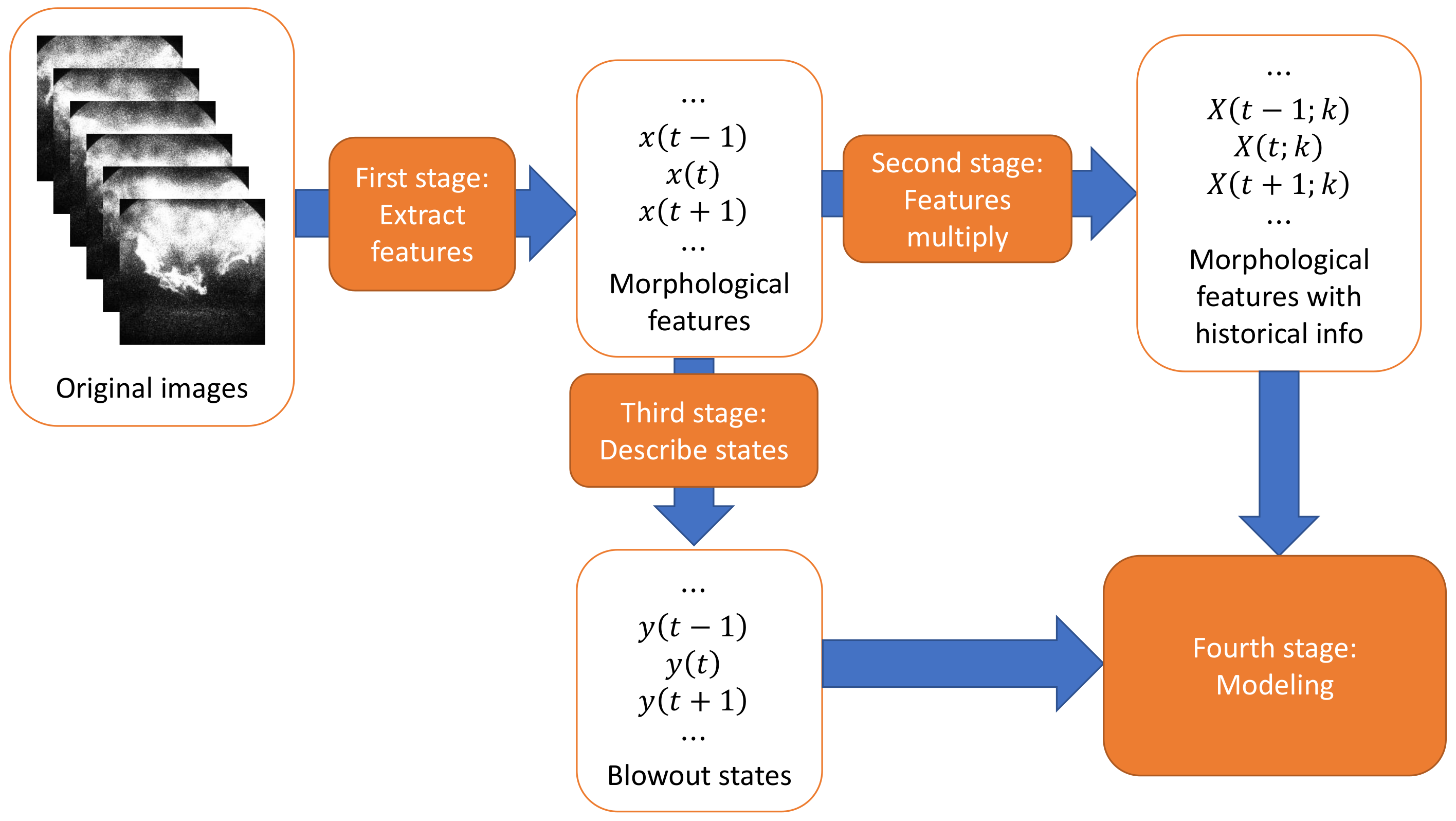
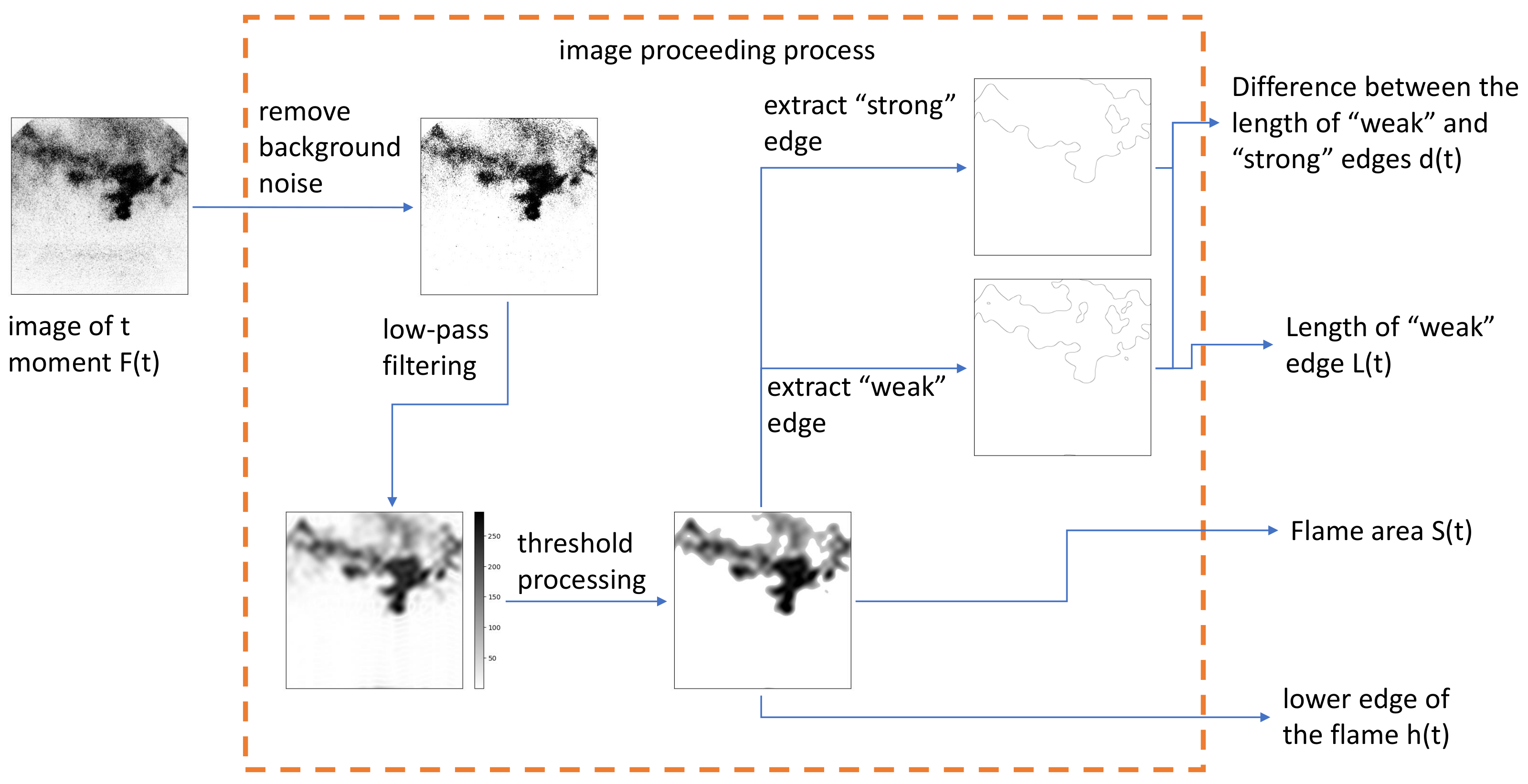
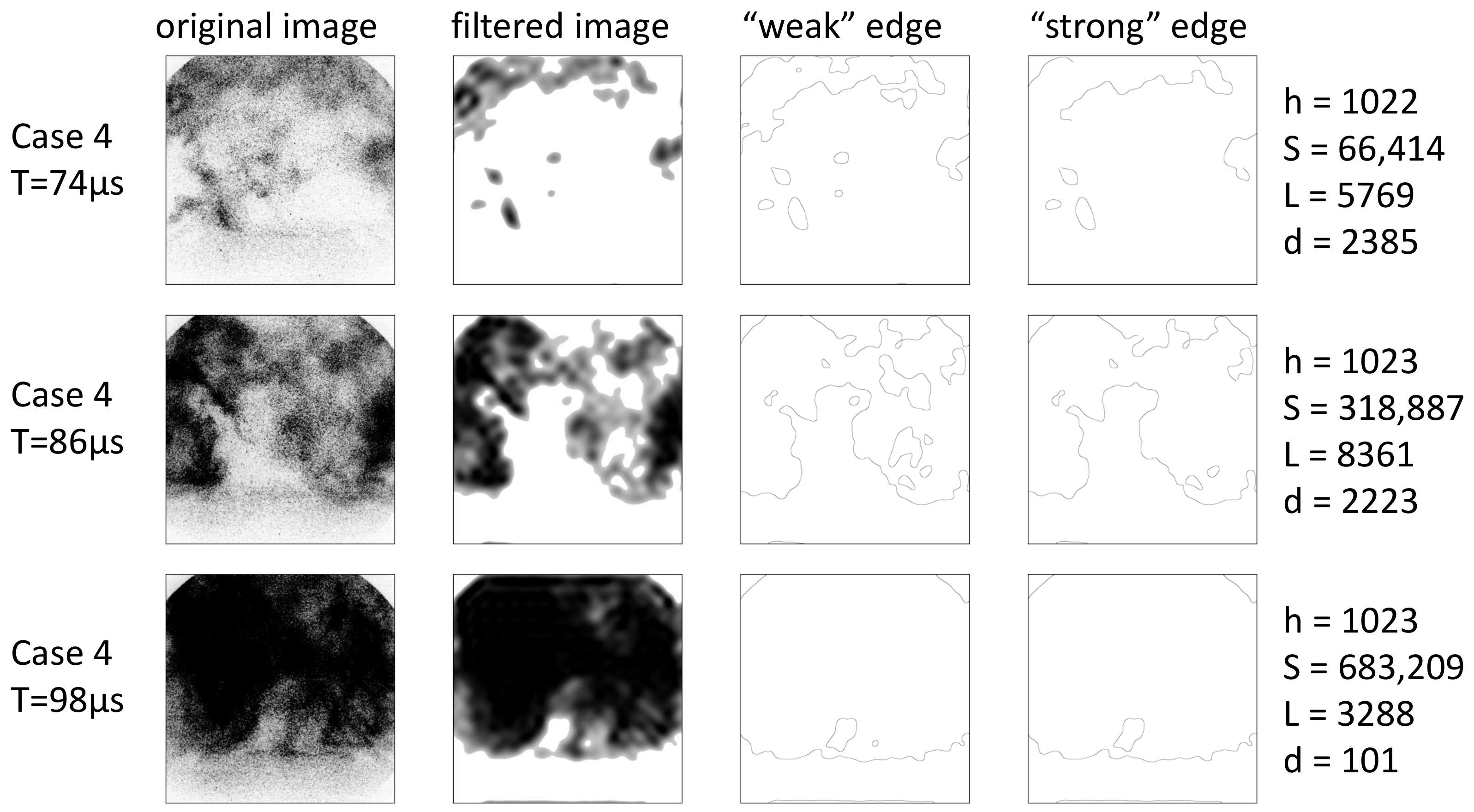
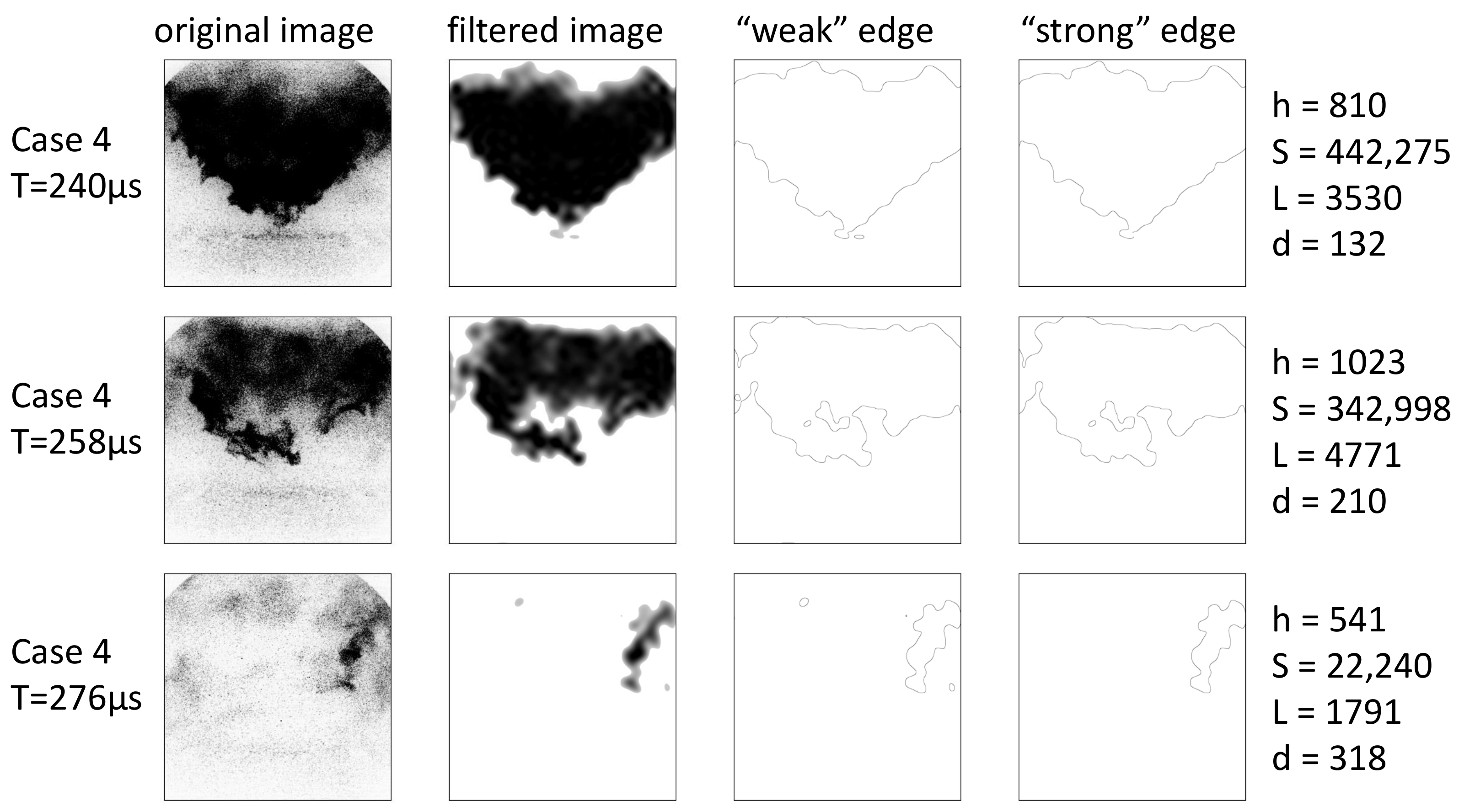

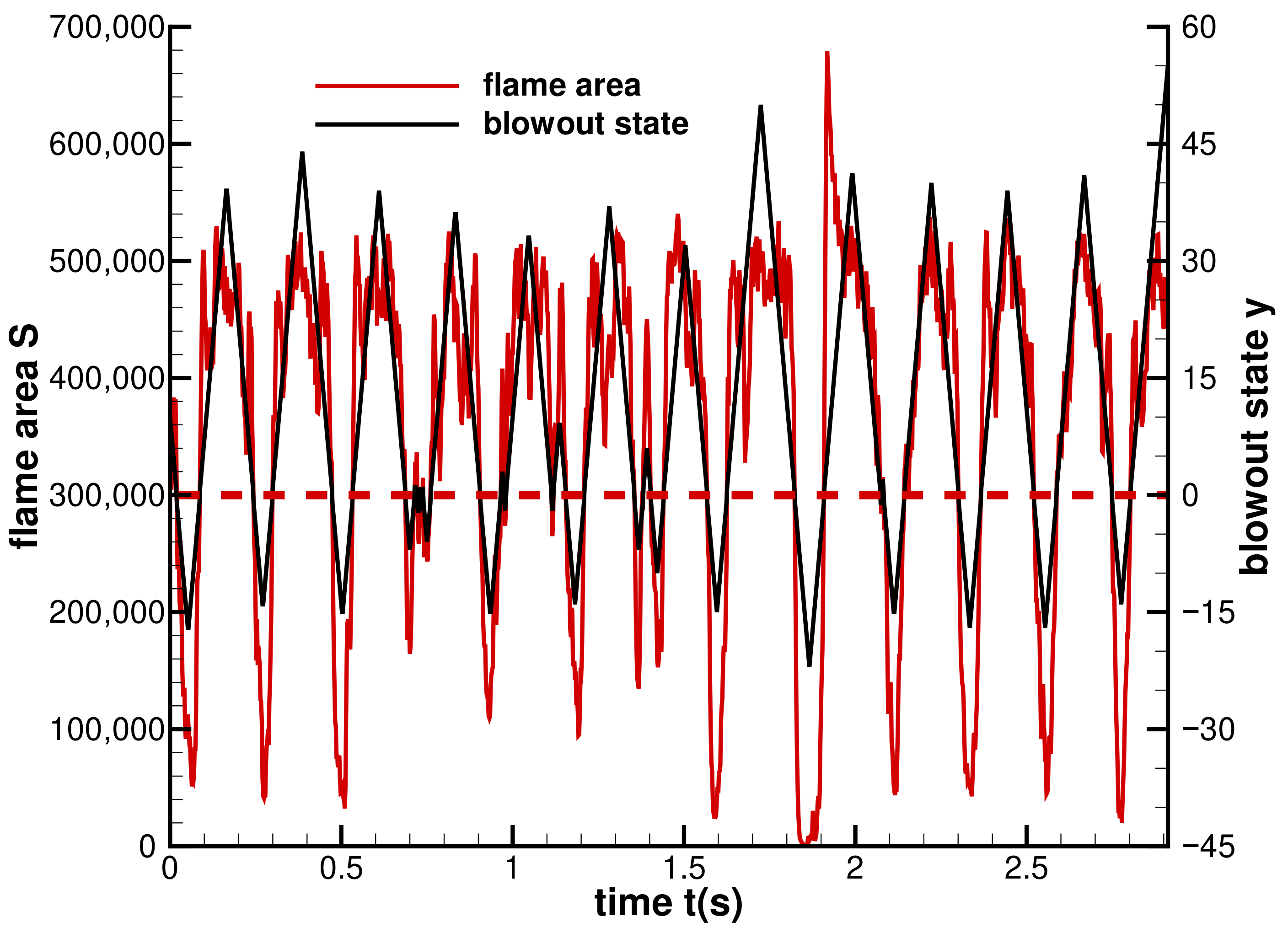


| Case | Total Air Flow Rate f (g/s) | Fuel–Air Ratio in the Pilot Stage | Fuel–Air Ratio in the Main Stage | Stratification Ratio | Total Fuel–Air Ratio |
|---|---|---|---|---|---|
| 1 | 2.5 | 0.96 | 0.64 | 1.495 | 0.677 |
| 2 | 2.5 | 0.93 | 0.64 | 1.443 | 0.674 |
| 3 | 2.5 | 0.98 | 0.64 | 1.526 | 0.680 |
| 4 | 3.0 | 0.96 | 0.65 | 1.477 | 0.685 |
| 5 | 3.0 | 0.96 | 0.63 | 1.517 | 0.669 |
| 6 | 3.0 | 0.94 | 0.64 | 1.464 | 0.675 |
| 7 | 3.5 | 0.96 | 0.65 | 1.473 | 0.686 |
| 8 | 3.5 | 0.96 | 0.63 | 1.521 | 0.668 |
| 9 | 3.5 | 0.96 | 0.64 | 1.496 | 0.677 |
| Model | Cases Used | RMSE | |
|---|---|---|---|
| (a) | 4 | 0.9890 | 2.64 |
| (b) | 1, 4, 7 | 0.9877 | 2.83 |
| (c) | 4–6 | 0.9791 | 3.53 |
| (d) | 1–9 | 0.9766 | 3.78 |
Disclaimer/Publisher’s Note: The statements, opinions and data contained in all publications are solely those of the individual author(s) and contributor(s) and not of MDPI and/or the editor(s). MDPI and/or the editor(s) disclaim responsibility for any injury to people or property resulting from any ideas, methods, instructions or products referred to in the content. |
© 2023 by the authors. Licensee MDPI, Basel, Switzerland. This article is an open access article distributed under the terms and conditions of the Creative Commons Attribution (CC BY) license (https://creativecommons.org/licenses/by/4.0/).
Share and Cite
Zhang, B.; Liu, H.; Liu, X.; Liu, H. Prediction Method of Swirling Flame Lean Blowout Based on Flame Image Morphological Features. Appl. Sci. 2023, 13, 3173. https://doi.org/10.3390/app13053173
Zhang B, Liu H, Liu X, Liu H. Prediction Method of Swirling Flame Lean Blowout Based on Flame Image Morphological Features. Applied Sciences. 2023; 13(5):3173. https://doi.org/10.3390/app13053173
Chicago/Turabian StyleZhang, Bin, Haoyang Liu, Xunchen Liu, and Hong Liu. 2023. "Prediction Method of Swirling Flame Lean Blowout Based on Flame Image Morphological Features" Applied Sciences 13, no. 5: 3173. https://doi.org/10.3390/app13053173
APA StyleZhang, B., Liu, H., Liu, X., & Liu, H. (2023). Prediction Method of Swirling Flame Lean Blowout Based on Flame Image Morphological Features. Applied Sciences, 13(5), 3173. https://doi.org/10.3390/app13053173







